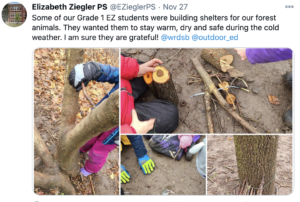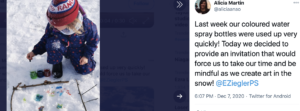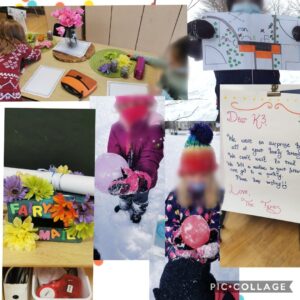
By Rebecca Seiling
How can we open up the doors and walls of our classroom to include more outdoor exploration and learning in our teaching? What is the schoolyard land teaching us? How does it complement the learning that happens indoors? What principles can guide our practice?
This year, many teachers have been encouraged to expand their classroom walls to include their schoolyards. In order to lessen germ transmission and increase fresh air time, teachers at Elizabeth Ziegler Public School in Waterloo reached out for resources and advice on bringing their learning outdoors. In a series of recursive workshops, groups of teachers experimented with ways that their practice could change to include meaningful, learning-filled, outdoor time.
Nature Play Design Principles
We started by briefly looking at David Sobel’s work. In his book Childhood and Nature: Design Principles for Educators, Sobel uses his observations of children at play around the world to outline seven design principles. When given opportunities to freely play outside, Sobel says, these are the types of experiences that children gravitate towards:
 Adventure
Adventure- Fantasy and imagination
- Animal allies
- Maps and paths
- Special places
- Small worlds
- Hunting and gathering
After reviewing these principles, one teacher wondered, “If this is how children naturally want to be playing, how can we use it to teach the curriculum?” This led to a discussion about how to be “sneaky” as teachers — having children learn where and when they least expect it — through outdoor play!
As a group, we experimented. Teachers received one green felt gnome “coat”, and were encouraged to use the land and natural materials around them to create a gnome home (small worlds play).

After a short time, we gathered back together and asked, “How could that activity fit into the curriculum expectations?” Ideas covered a range of subjects and grade levels, including:
- Art: Colour palette in nature, sculpture and spatial design
- French: Words for home, natural building materials, rooms in a home, verbs like “to build,” “to plan,” “to work together”
- Science: Biodiversity – what is growing in the schoolyard that the gnomes could use for their home? How many kinds of trees/plants/seeds can you find that can be used in the homes?
- Science: Structures and mechanisms – building a strong, stable structure for the gnome
- Language: Communicating ideas in a small group, potentially learning new vocabulary as they learn to identify the natural building materials they are finding (leaves, seed pods, etc.), procedural writing (first I built a structure for the walls, then I added bark for a roof, etc.), creative writing about the gnome’s adventures
- Social and Personal Skills: Self-regulation, cooperation, negotiation skills
- Social Studies: Communities – building a gnome village – what would they need in their community?
In subsequent weeks, teachers experimented in their schoolyard spaces. Below are some examples of their play and learning experiences, organized into some of Sobel’s design principles.
Small Worlds
A Grade One class gathered natural materials to work on building small worlds in a little forested area of the property. And a Grade 3/4 class created an insect hotel.


Hunting and Gathering
Language arts outdoors? No problem! Here is an example of another class using the outdoors for literacy prompts (hunting for letters written on burlap squares), reporting a high level of engagement. Sit spots outdoors can help children to regulate their actions and emotions, bringing fresh focus to the task at hand.
Adventure
During a time when it is difficult to have regular exercise indoors with a class, physical education opportunities can be enhanced outdoors too. Children can practice their gross and fine motor skills, moving their bodies around much more than indoor classrooms allow, while also using their imaginations — like the photo below demonstrates.


Fantasy and Imagination
Artistic opportunities abound in nature! Opportunities to dive into a fantasy world can not only fuel children’s creativity and imagination, but provide prompts for writing and reading back inside the classroom.
One Kindergarten class created a coloured snow art invitation:

Another Kindergarten teacher made a class set of felt “gnomes”, which provided a week’s worth of prompts at school. Children wrote stories about their gnomes’ adventures, then the gnomes journeyed to the students’ homes. Some families took photos of the gnomes and wrote about what they were doing in their new homes. This “gnomework homework” provided a link between home and school that continued the learning and creativity at home.
Maps and Paths
Recently, Kindergarten teacher Alicia Martin found some letter-writing and map-making fairies along with her class. I can only imagine what this wonderful discovery would have been like! This exciting week (combining small world, fantasy/imagination, and map/path prompts) tied in language arts, arts and spatial sense, cardinal directions and map-reading, and probably much, much more!


Special Places
Martin also helped students to build a relationship to the land and extend their learning beyond the classroom by observing the winter birds and providing treats for them. These opportunities teach reciprocity and ways to give back to the land and creatures with whom they share space. Waiting for chickadees to land on open palms teaches patience, respect, and self regulation skills. Like a “standing sit spot” practice, this can root children to the land in a new way, creating special memories and places on the schoolyard.

The land invites us to listen and observe, play, learn together, become excited about new discoveries, and use our imaginations. In an often noisy world, the land can calm and quiet us. When we open the walls of our classrooms to include the outdoors, we can experience deep learning and meaningful connections, and discover new pathways forward.
If you’re teaching in a classroom this year, how has COVID-19 allowed for more freedom to experiment outdoors with your class? How have you opened your walls? Which of these design principles could help to inform your outdoor teaching practice?

